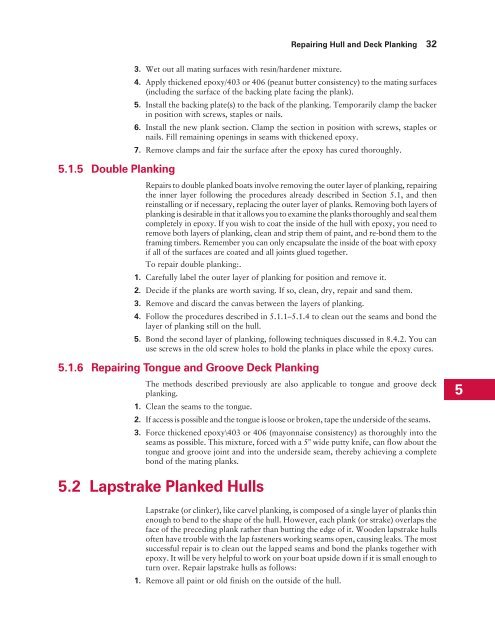Wooden Boat Restoration Repair - WEST SYSTEM Epoxy
Wooden Boat Restoration Repair - WEST SYSTEM Epoxy
Wooden Boat Restoration Repair - WEST SYSTEM Epoxy
Create successful ePaper yourself
Turn your PDF publications into a flip-book with our unique Google optimized e-Paper software.
5.1.5 Double Planking<br />
3. Wet out all mating surfaces with resin/hardener mixture.<br />
4. Apply thickened epoxy/403 or 406 (peanut butter consistency) to the mating surfaces<br />
(including the surface of the backing plate facing the plank).<br />
5. Install the backing plate(s) to the back of the planking. Temporarily clamp the backer<br />
in position with screws, staples or nails.<br />
6. Install the new plank section. Clamp the section in position with screws, staples or<br />
nails. Fill remaining openings in seams with thickened epoxy.<br />
7. Remove clamps and fair the surface after the epoxy has cured thoroughly.<br />
<strong>Repair</strong>s to double planked boats involve removing the outer layer of planking, repairing<br />
the inner layer following the procedures already described in Section 5.1, and then<br />
reinstalling or if necessary, replacing the outer layer of planks. Removing both layers of<br />
planking is desirable in that it allows you to examine the planks thoroughly and seal them<br />
completely in epoxy. If you wish to coat the inside of the hull with epoxy, you need to<br />
remove both layers of planking, clean and strip them of paint, and re-bond them to the<br />
framing timbers. Remember you can only encapsulate the inside of the boat with epoxy<br />
if all of the surfaces are coated and all joints glued together.<br />
To repair double planking:.<br />
1. Carefully label the outer layer of planking for position and remove it.<br />
2. Decide if the planks are worth saving. If so, clean, dry, repair and sand them.<br />
3. Remove and discard the canvas between the layers of planking.<br />
4. Follow the procedures described in 5.1.1–5.1.4 to clean out the seams and bond the<br />
layer of planking still on the hull.<br />
5. Bond the second layer of planking, following techniques discussed in 8.4.2. You can<br />
use screws in the old screw holes to hold the planks in place while the epoxy cures.<br />
5.1.6 <strong>Repair</strong>ing Tongue and Groove Deck Planking<br />
The methods described previously are also applicable to tongue and groove deck<br />
planking.<br />
1. Clean the seams to the tongue.<br />
2. If access is possible and the tongue is loose or broken, tape the underside of the seams.<br />
3. Force thickened epoxy\403 or 406 (mayonnaise consistency) as thoroughly into the<br />
seams as possible. This mixture, forced with a 5" wide putty knife, can flow about the<br />
tongue and groove joint and into the underside seam, thereby achieving a complete<br />
bond of the mating planks.<br />
5.2 Lapstrake Planked Hulls<br />
<strong>Repair</strong>ing Hull and Deck Planking 32<br />
Lapstrake (or clinker), like carvel planking, is composed of a single layer of planks thin<br />
enough to bend to the shape of the hull. However, each plank (or strake) overlaps the<br />
face of the preceding plank rather than butting the edge of it. <strong>Wooden</strong> lapstrake hulls<br />
often have trouble with the lap fasteners working seams open, causing leaks. The most<br />
successful repair is to clean out the lapped seams and bond the planks together with<br />
epoxy. It will be very helpful to work on your boat upside down if it is small enough to<br />
turn over. <strong>Repair</strong> lapstrake hulls as follows:<br />
1. Remove all paint or old finish on the outside of the hull.<br />
5
















